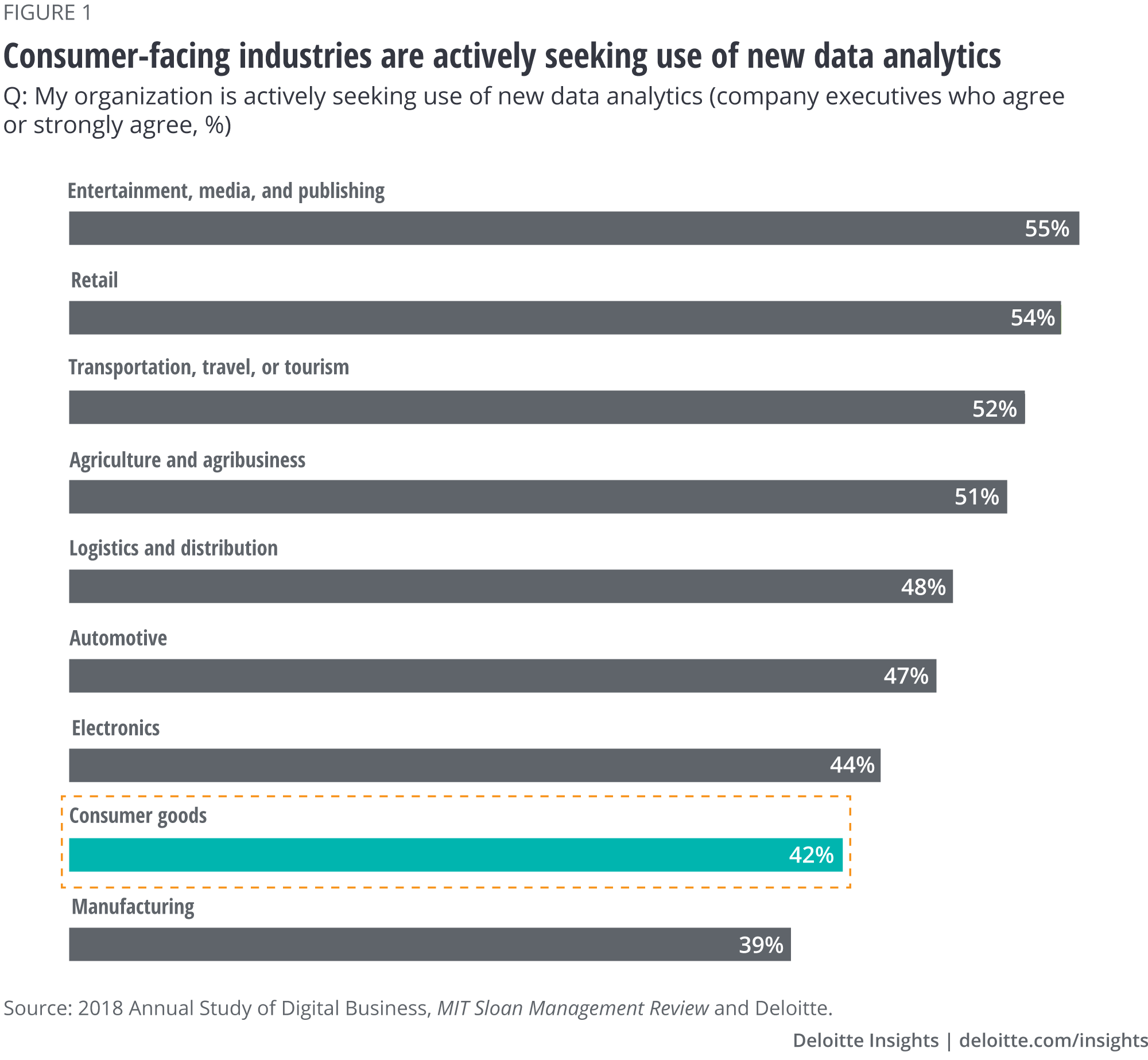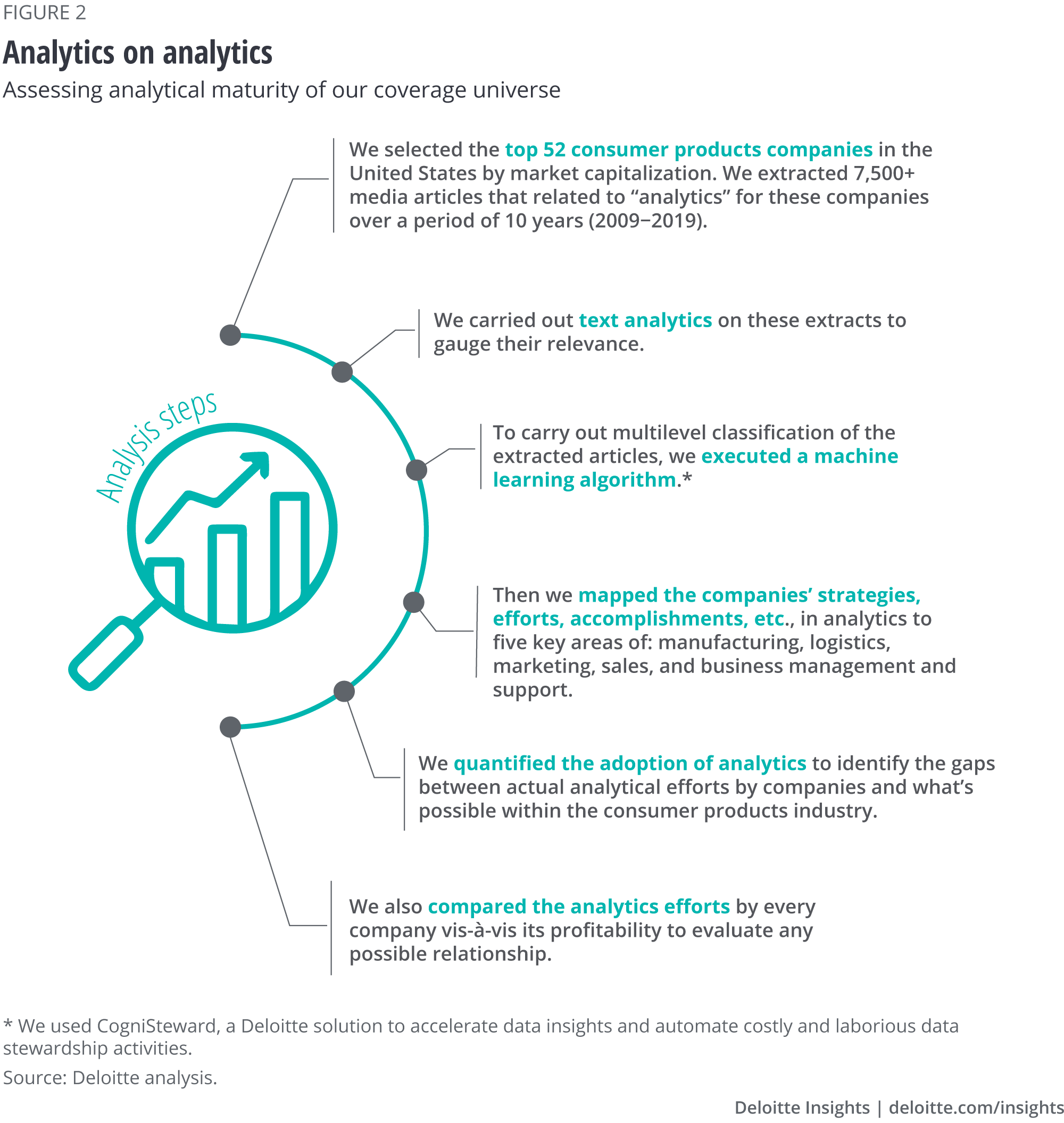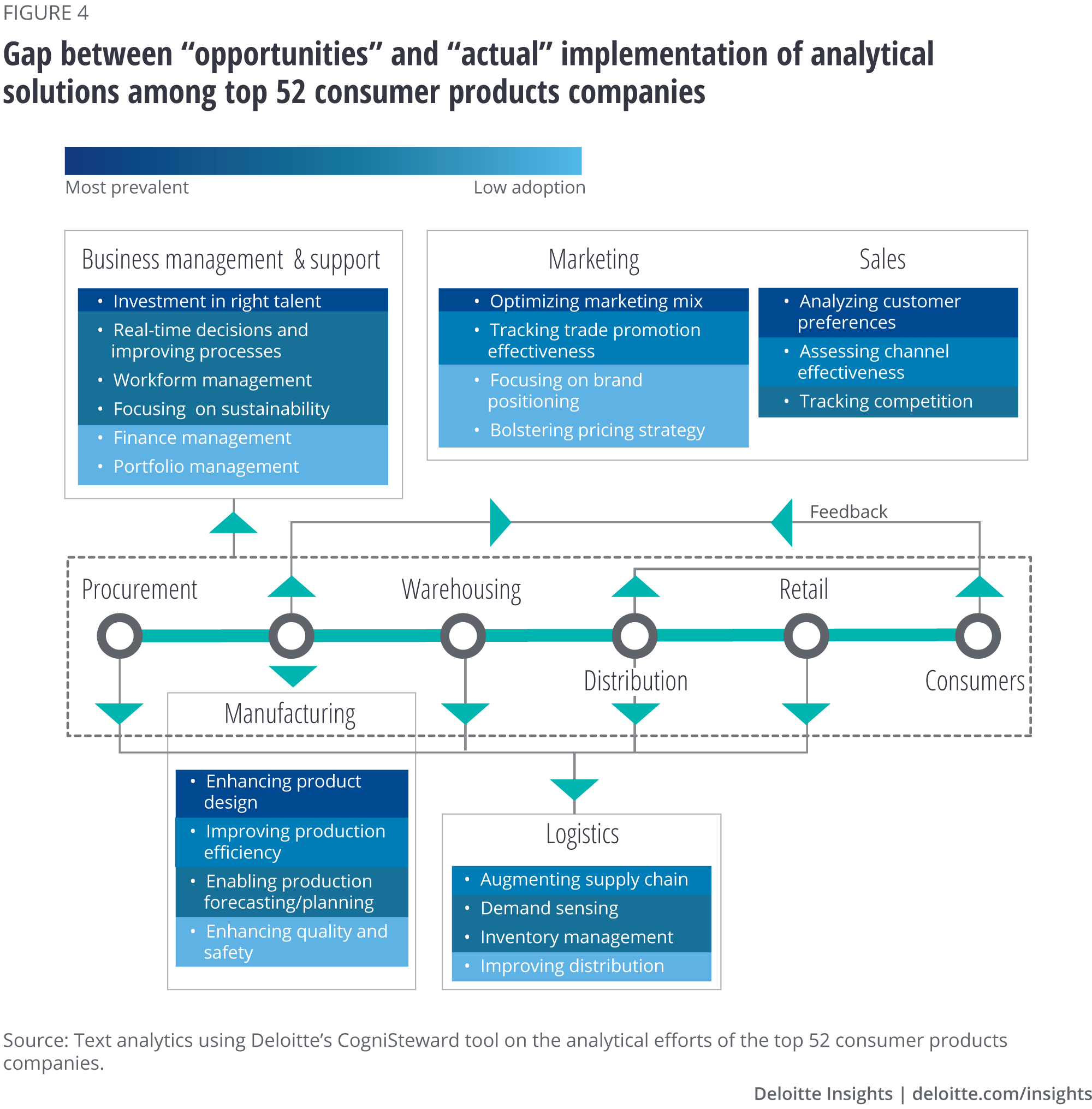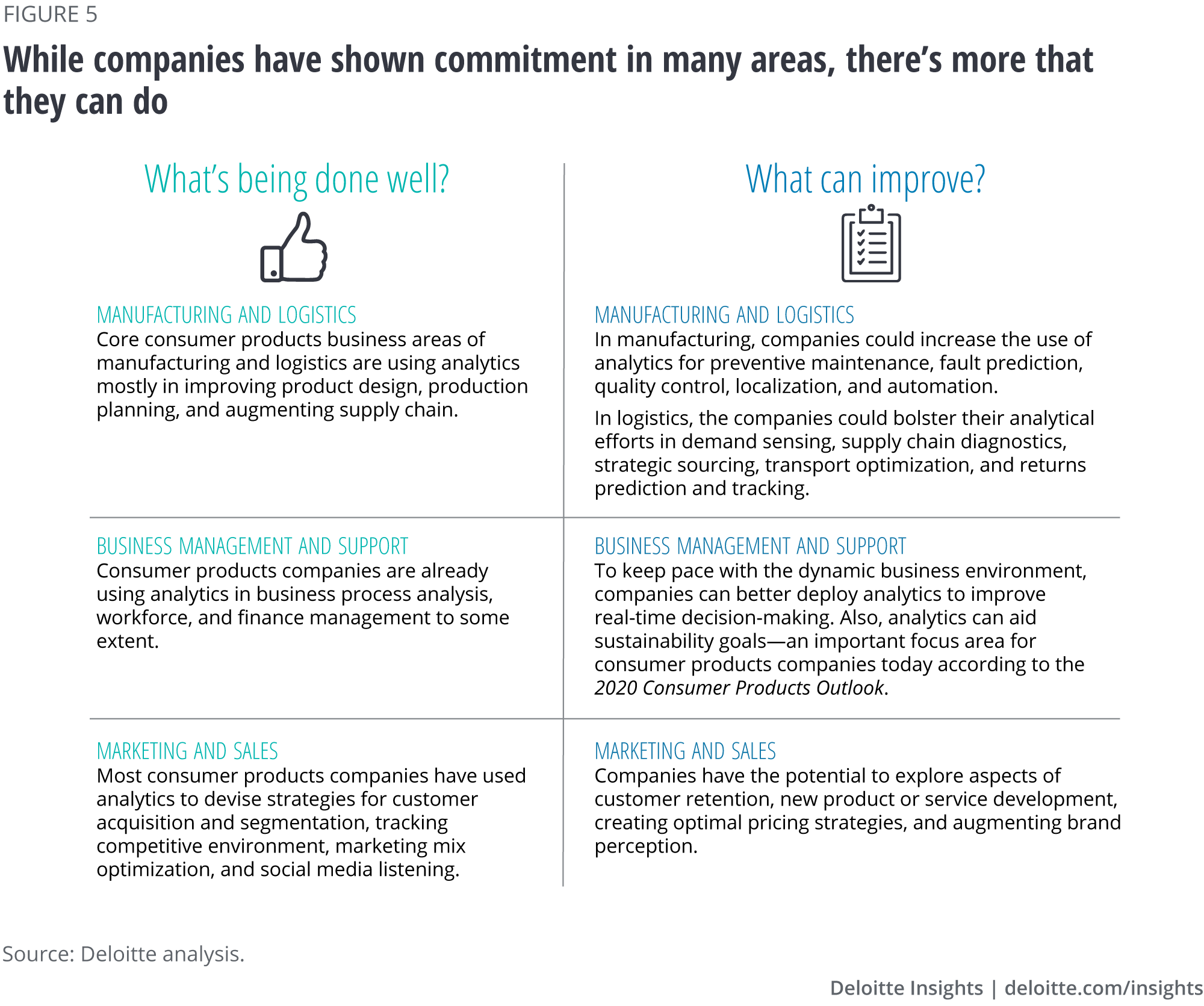
How can consumer products companies stay relevant and be future-ready with analytics? With good data comes great analytics
8 minute read
12 June 2020
Our analytics-on-analytics research reveals the time to invest in analytics is now.
At the start of 2020, the consumer products industry was addressing traditional operational issues and slowly adapting to emerging consumer trends. However, the COVID-19 outbreak may have fundamentally changed consumer demand and the integrated supply chains that serviced it, defining a “new normal” for businesses and altering some category dynamics forever. The acceleration to advanced analytics has become table stakes for companies that need to adjust to this new normal.
Learn more
Explore the consumer products & retail collection
Read more from the analytics collection
Learn about Deloitte’s services
Go straight to smart. Get the Deloitte Insights app
While many consumer-centered companies have steadily invested in data collection, generating tons of potentially valuable information, as much as 80% of this customer data is not mined,1 meaning companies may not be fully clued into their customers’ needs. Our research reveals that the companies have not tapped completely into the data generated internally within their value chain as well.
The importance of analytics has never been more obvious—the lack of direct-impact metrics has made it difficult for companies to envision the value of data and analytics in improving business agility and sustaining operational performance. Our analytics-on-analytics approach supports the role of analytics in enabling enhanced performance. Our research also shows:
- Users of analytics stand to gain from adoption, regardless of where they are in the adoption curve.
- Heavy users are typically better at cost management than nonadopters, reaping higher profits.
- Companies consistently investing in analytics and widening their solutions spectrum are better poised to handle business disruptors and their impact on the different aspects of business in the long term.
- Speed to value from adoption of analytics varies depending on the business area companies choose to invest in.
Thus, consumer-centered companies stand to win with analytics. But what is the reality of implementing analytics?
Consumer products industry has a long way to go to unlock the true potential of analytics
A 2018 study2 found that consumer products executives rated the industry as being in the mid-to-lower end of the digital-maturity spectrum. Additionally, only four in 10 consumer products executives felt that their organization was actively seeking use of new data analytics to improve performance (figure 1).

Though the consumer products industry has boosted its digital efforts, many companies are not agile or even agile-ready, face distributed decision-making, struggle with buying and implementing the right technology, etc. As a result, their ability to manage risks may be limited.
It is not surprising then that our analysis (see the sidebar, “Research methodology”) reveals very few consumer products companies are at analytical maturity. Given the changes in fundamental consumer behavior and the current uncertain environment, the hallmark of forward-looking companies is their ability to quickly adapt to the “new normal” by deploying scenario planning and analytics to their true potential.
Research methodology: “Analytics-on-analytics” research to assess consumer products companies’ analytical maturity
To analyze the maturity of consumer products companies’ analytical efforts, we took the data-savvy route and applied advanced text analytics (figure 2).

So, what does winning look like? For any business, it can be visualized using three aspects, namely:
- Where are we now: Self-evaluation by a company on its current analytical efforts
- Where are we going: Clarity on the desired end state from the adoption of analytics, such as being agile and future-ready or being data-ready to manage uncertain business environments
- How can we reach there: A clear road map to move up on the analytical solutions curve
Through such an assessment, companies could identify themselves in one of the four major categories (figure 3).

Nonusers, clearly, are those uninitiated in a business area. Other users are defined by the sophistication of their analytical solutions in each business area. We found that increased adoption in areas such as consumer insights, marketing, sales, supply chain, and manufacturing triggered further efforts in these areas. And as this usage went up, the need for more predictive and prescriptive solutions emerged, enhancing the analytics portfolio of these companies.
How to win with analytics
Pockets of excellence within consumer products: In which business area should a company invest first?
For companies that have not started, the message is clear—start yesterday! For many years, practically every consumer products company has cited “margin improvement and cost reduction” as one of the top focus areas.3 Our analysis reveals that companies with higher adoption rates have consistently lower cost of goods sold (COGS)/revenue ratios than nonusers, with the difference being as high as 12% in some years. A gap of that magnitude reflects favorably in profitability too—the difference was as high as 16% in gross margin. For an industry that hasn’t seen the return on assets of more than 3–4% in the last decade, this can be a great way to boost the growth by improving efficiencies.
That said, a nonuser consumer products company could stand to benefit by using analytics in any business area. To prioritize the areas for investment, companies should assess the business environment, lean on decision science to start strategically, and assess the speed to value.
Starting slow: Can light users win?
No matter the level of analytical effort, there’s something for everyone. This has been observed particularly in relation to light users’ efforts in sales analytics. The solutions deployed in this space are descriptive, so the heavy users, in particular, do not have an edge here. But, over 2009–2019, light users have shown consistently lower selling, general, and administrative (SG&A) margins than other users—a metric that typically includes costs associated with marketing among other overhead costs. During this period, the industry benchmark SG&A cost margins dropped 4.2% and heavy users’ SG&A margins dropped 1.2%. Light users reaped quick benefits from their initial effort in this area and surpassed the other users—with a reduction of 6.1%. Moreover, because of their smaller market capitalization, the impact of their improved cost efficiencies was amplified and reflected in higher revenue growth compared to other players over 2009–2019.
Winning today: Who’s benefitting the most from analytics now?
In the short term, moderate users have seemed to benefit the most from analytics. This has been observed on many metrics across the five main business areas. In logistics, for most years between 2009 and 2019, moderate users outperformed heavy users and the industry benchmark on accounts receivables turnover, average days sales outstanding, average days payables outstanding, and average cash conversion cycle. The same goes with their performance on some of the key manufacturing-related metrics, such as COGS/revenue, other operating expenses/revenue, and fixed asset turnover, which reflects in their gross margin and return on assets.
However, if we look at the industry landscape today, it’s the heavy users that have developed a more sustained performance edge due to their foresight of investing in analytics early on and building more integrated platforms. They have also demonstrated more agility in adapting to irregular demand, evolving channel patterns, and are also skillfully strategizing their last mile efforts.
Winning in the long term—what do heavy users teach us on being future-ready?
Over the last decade, what have the heavy users done well? Many things, including their foresight about wanting to be future-ready, their deliberate approach toward deploying analytics, seeing first-hand benefits in their financial and soft metrics, and the consequent drive to invest back in analytics. Between 2009 and 2019, heavy users experienced improved production efficiency, better cash flow from operations through effective cost management, and higher investments in capital-intensive projects aimed at growth. In logistics, they showed superior performance in managing inventory and payables and have consistently achieved the best cash conversion cycle. These efforts also reflect in their revenue growth in this period. Further, they have better cost management pertaining to sales, marketing, and other overhead expenses, resulting in consistently highest EBITDA margins, signifying stable business earnings.
To understand which of the above four situations best applies to your business, it is important to assess the analytics adoption maturity of the consumer industry and where you stand in this milieu. A candid reality check, however, is good first step.
Opportunity versus effort: Where consumer products companies are investing and whether that’s enough
To better understand where consumer products companies’ analytical focus lay in the last decade, we analyzed the analytics-related literature from 52 companies between 2009 and 2019. In the first five years, companies mainly focused on core areas, implementing automation for efficiency and quality, design and process improvement, inventory planning, and supply chain modernization. Interests shifted from 2015 with advances in marketing technology and social media explosion. Companies’ focus moved to improving their last-mile efforts.
But are their efforts and investments in business analytics enough? The answer is multifaceted. In steady business conditions, companies would typically prefer investing in core areas. But in nonconfirmatory, unique business situations, they should be agile. Their investment focus might shift as business needs evolve and when consumer behaviors alter. For example, when consumers stockpile a few select categories placing others on the backseat, the spotlight would move to supply chain and sales, while ensuring partner management.
Today, most companies have their own pockets of excellence in adopting analytics and very few have managed to master all the five business areas consistently. So, where do their efforts stand vis-à-vis the potential? This analysis at every stage of consumer products value chain reveals a significant gap (figure 4).

A deep dive into the gap between actual implementation and what’s possible revealed that within specific business areas, there’s considerable room for improvement (figure 5).

Thus, so far, we’ve established the link between analytical efforts and profitability, how a few leading heavy users have benefitted by using systematically implemented analytics, and the untapped potential of analytics. These highlight the obvious incentives that consumer products companies have to invest further in analytics.
What’s ahead? Augmenting every aspect of the consumer products value chain to prepare for the “new normal”
Going ahead, consumer products companies should prudently deploy analytics to cope with uncertain business situations that may impact their long-term strategies. They should account for management of working capital, risks to the supply chain, and possible long-term shifts in consumer behavior. Analytics can help them devise practical next steps, including developing contingency plans and supporting business continuity.
The global customer analytics market is poised to grow to US$24 billion by 2025, a CAGR of 18% between 2020 and 2025.4 With consumer products companies across the globe5 recognizing what’s achievable via analytics, their efforts can enable the overall market growth. Our analysis of recent investor call transcripts validates that companies that were already actively investing in analytics in 2018—including light users—increased their investment in 2019 via in-house efforts or acquisitions. Many heavy users, who are leading in the analytics space, are experiencing the benefits of analytics first hand, especially in the current turbulent business environment. Per their recent investor call transcripts, they have geared up their efforts to strengthen consumer insights, manage supply chain/logistics, and improve marketing strategies. They’re meeting near-term goals across business areas.
For the companies that are in early phases of their analytical lives, it could be a good idea to assess how analytics can help achieve their broader business goals and kick-start the effort. They should sync their analytics vision, investments, and performance by calculatedly embedding analytics across the enterprise, including talent, process, data, and technology. This can improve their "speed to insight,” thereby empowering decision-makers with better and quicker information to improve performance and unlock growth. And in a turbulent business environment, they should be able to respond, recover, and thrive quicker than those behind in the analytics adoption curve.
© 2021. See Terms of Use for more information.
More on analytics
-
Macro technology forces Article5 years ago
-
Diffusing agility across the organization Article5 years ago
-
How analytics and AI-driven enterprises thrive Article5 years ago
-
Infusing data analytics and AI Article5 years ago
-
Modernize management of big data Article6 years ago
-
Data & Analytics Collection











